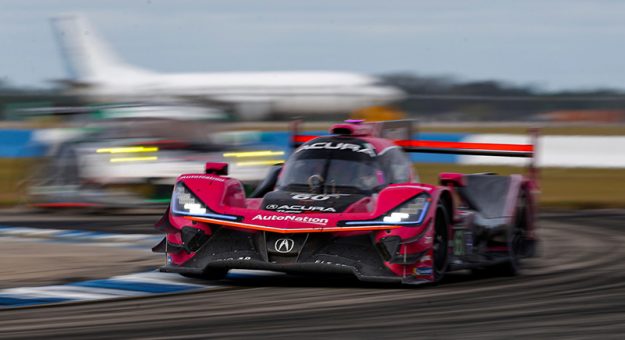Physical Training Crucial to Remaining Strong Physically and Mentally
By Holly Cain
DAYTONA BEACH, Fla. – Temperatures nearing 90 degrees, cloudless sunny skies, 3.74 miles of twists, turns and bumps endured for a complete trip around the clock – this is the famed Mobil 1 Twelve Hours of Sebring Presented by Advance Auto Parts.
Many consider the Sebring race the most physically demanding drive on the IMSA WeatherTech SportsCar Championship schedule. And drivers were already preparing – both mentally and physically – for the March 19 second stop on the 2022 schedule even as they showed up for the season’s first race in January, the Rolex 24 At Daytona.
Offseason training followed by workouts between the two endurance races – a seven-week span – leading to the iconic Sebring race call for some of the most disciplined training schedules of the entire year, competitors insist.
“When we race at Daytona, you can be in car three, three and half hours, but it’s more demanding being in the car one hour in Sebring,’’ Renger van der Zande, co-driver of the Chip Ganassi Racing No. 01 Cadillac V-Performance Academy Cadillac DPi-V.R, said. “Obviously, it’s the track, but also the temperatures. That’s the hardest part. Luckily, we have two months to get acclimated and do the heat training.”
The difference in temperature between Daytona in January and Sebring in mid-March can sometimes vary by 40 degrees. Add in the physical demands of the drivers negotiating the venerable course and it means fitness can be a significant factor in deciding a team’s outcome.
Increasingly, drivers train up for the Sebring race, which at half as long as Daytona, calls for a more intense pace. And certainly the 17-turn circuit and former airfield in rural Central Florida demands a huge mental and physical game; one unlike any other venue on the schedule.
“Sebring is grueling! It’s the hardest one of the calendar,’’ said Earl Bamber of the No. 02 Cadillac Accessories entry from Chip Ganassi Racing. “It’s hot and it’s bumpy. Comparatively, Daytona is easy, but Sebring is just pounding the whole way and obviously more a sprint, so a lot harder in that way. I would say everyone trains up to get to Sebring.”
For some, the training is quite intense. Several drivers actually run marathons or even enter triathlons between the two endurance car races.
Finished the triathlon at @DAYTONA today. I now shall rest. 😅 pic.twitter.com/79fLrwoUTH
— Ricky Taylor (@RickyTaylorRace) December 5, 2021
“You do your gym and cardio at home and you always start your season your fittest by normal metrics, but you’re not really ‘driving fit,’ so to speak,’’ said Ricky Taylor, a two-time series champion and Florida native.
“It’s different when you drive the race car,” the co-driver of the No. 10 Konica Minolta Acura ARX-05 added. “And it’s actually a really funny stretch (to start the season) because you lose fitness when you drive at Daytona if you compare bicycle to bicycle or weight room to weight room. That gap between Daytona and Sebring is when you try to build it back up at home.”
Through the years, drivers have not only put a huge emphasis on physical training, but have finetuned that focus according to the season schedule. The endurance races at Daytona and Sebring present a different challenge than the shorter “sprint” races – the 100-minute and the 2-hour, 40-minute races that make up the majority of the rest of the season.
The mental focus is extremely important after multiple long stints in the Sebring heat, but being fit and physically able to handle the “all in” day of bumps and sharp turns can be the difference between a legendary Sebring trophy or not. Intense physical preparation is not only prevalent on the grid but expected of the sports car set.
“The hard part is not driving (during those weeks) after Daytona,’’ van der Zande said. “So being fit as far as your muscle memory and reaction is hard. I would say some drivers would do go-karting, simulation work. There’s really no other way.”
The payoff? Becoming part of a highly respected and elite winner’s club at a track where athleticism is as important as strategy and speed.
“Sun and bumps, see you again in a few weeks,’’ Taylor posted on his social media account.
Sun and bumps. See you again in a few weeks @sebringraceway. pic.twitter.com/hUyu16wFTh
— Ricky Taylor (@RickyTaylorRace) February 18, 2022
On-track action at Sebring International Raceway runs from March 16-19, capped off by the Twelve Hours of Sebring race that begins at 10:10 a.m. ET Saturday, March 19. Peacock’s live streaming coverage starts at 10 a.m., with USA picking up the NBC Sports telecast at 3:30 p.m. through the end of the race. IMSA Radio also provides a flag-to-flag broadcast. Tickets for the race are available at sebringraceway.com.
